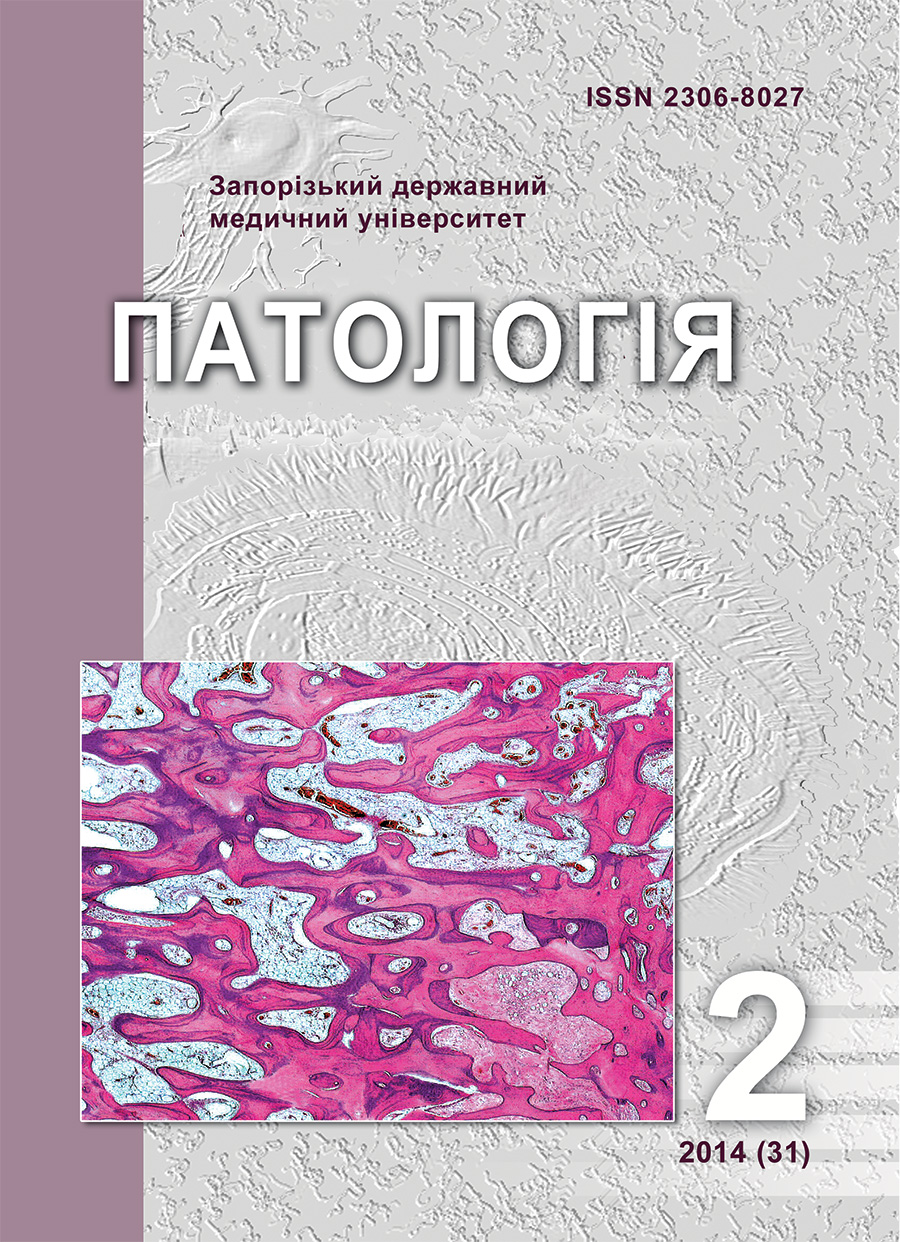Association of polymorphism of genes of folate cycle and blood serum content of interleukin-33 in patients with high summary cardiovascular risk on the combined therapy of arterial hypertension
DOI:
https://doi.org/10.14739/2310-1237.2014.2.28565Keywords:
Risk Factors, Cardiovascular Diseases, Interleukins, Genetic PolymorfismAbstract
Aim. The study of genetic factors of cardiovascular diseases is of great importance, as the screening of major risk factors that cause the development of cardiovascular accidents across the globe does not enable identifying at least half of those who appear to suffer from the diseases in the future. In order to solve this particular problem, an effect of combined therapy of hypertension on the interleukin 33 (IL-33) in patients who appear to be at high risk of developing cardiovascular diseases as well as the presence of polymorphisms of genes of the folate cycle (MTHFR C677T, A1298G, MTR А2756G, MTRR A66G) have been studied.
Methods and results. 41 women suffering from arterial hypertension as well as 10 patients at risk of SCORE<5% were examined. Using the enzyme immunoassay, serum IL-33 concentration before and after 6 months of treatment by combined medication (Noliprel A Forte, Servier) was studied. In addition, all the patients underwent the molecular genetic analysis of blood samples. As the result, the patients with arterial hypertension and ones being at high total cardiovascular disease risk showed the increased concentration of IL-33 in blood. Moreover, the relationship between its concentration in blood and polymorphism of gene MTRR A66G was established.
Conclusion. This proves the key role of the polymorphism of gene MTRR A66G in influencing the IL-33 concentration index in blood.
References
O’Donnell, M., Xavier, D., Liu, L., & Zhang, H. (2010). Risk factors for ischaemic and intracerebral haemorrhagic stroke in 22 countries (the INTERSTROKE Study): a case-control study. Lancet, 376, 112–123.
Kathiresan, S., & Srivastava, D. (2012). Genetics of human cardiovascular disease. Cell, 148(6), 1242–57.
Puzyrev, V. P. (2011). Fenomo-genomnye otnosheniya i patogenetika mnogofaktornykh zabolevanij [Hairdryer-genomic relationships and patogenetika multifactorial diseases]. Vestnik Rossijskoj AMN, 9, 17–27. [in Russian].
Baszczuk, A., Kopczyński, Z., & Thielemann, A. (2014). Endothelial dysfunction in patients with primary hypertension and hyperhomocysteinemia. PostepyHigMedDosw, 68, 91–100.
Komarov, A. L., Shahmatova, O. O., Rebrikov, D. V., Trofimov, D. Yu., Kotkina, T. I., Ilyushchenko, T. A., et al. (2011). Vliyanie geneticheskikh faktorov, associirovannykh s trombozami, na dolgosrochnyj prognoz bol'nykh khronicheskoj ishemicheskoj bolezn'yu serdca [The influence of genetic factors associated with thrombosis on long-term prognosis of patients with chronic ischemic heart disease]. Racional'naya farmakoterapiya v kardiologii., 7(4), 409–425. [in Russian].
Miller, A. M. (2011). Role of IL-33 in inflammation and disease. J. Inflamm, 8(1), 22.
Zeyda, M., Wernly, B., & Demyanets, S. (2013). Severe obesity increases adipose tissue expression of interleukin-33 and its receptor ST2, both predominantly detectable in endothelial cells of human adipose tissue. Int. J. Obes, 37(5), 658–665.
(2001) PROGRESS Collaborative Group. Randomised trial of perindopril-based blood pressure lowering regimen among 6,105 individuals with previous stroke or transient ischemic attack. Lancet,358, 1033–1041.
Patel, A. ADVANCE Collaborative Group. (2007). Effects of fixed combination of perindopril and indapamide on macrovascular and microvascular outcomes in patients with type 2 diabetes mellitus (the ADVANCE trial): a randomized controlled trial. Lancet, 370, 829–840.
Zhuo, J., Ohishi, M., Mendelson, F.,& Florey, H. (2000). Effects of chronic perindopril treatment on vascular ACE, AT1 receptor and nitric oxyde synthase expression in patients with ischaemic heart disease. J. Hypertension, 8(4), 5–24.
Nedogoda, S. V., Ledyaeva, A. A., & Chumachok, E. V (2011). E`ffektivnost' perindoprila u pacientov s arterial'noj gipertenziej i ozhireniem [The effectiveness of perindopril in patients with hypertension and obesity]. Kardiologiya, 51(11), 38–44.
Bova, I., Chapman, J., & Sylantiev, C. (1999). The A677V methylenetetrahydrofolate reductase gene polymorphism and carotid atherosclerosis. Stroke, 30, 2180–2182.
Mazza, A., Giugliano, D., & Motti, C. (2000).MTHFR genotype and low homocysteine in uncomplicated type 2 diabetic patients. Atherosclerosis, 149, 223–224.
Selhub, J., Jacques, P. F., & Bostom, A. G. (1995). Association between plasma homocysteine concentrations and extracranial carotid-artery stenosis. NEnglJMed, 332, 286–291.
Kovalyova, O. M., & Honchar, O. V. (2014). Interleykin-33 ta osoblyvosti strukturno-funktsional'noho remodelyuvannya livoho shlunochka sertsya u patsiyentiv z hipertonichnoyu khvoroboyu ta ozhyrinnyam [Interleukin-33 and left ventricular structural and functional remodeling in hypertensive patients with obesity]. Ukrayins'kyy kardiolohichnyy zhurnal, 1, 56–61. [in Ukrainian].
Downloads
How to Cite
Issue
Section
License
Authors retain copyright and grant the journal right of first publication with the work simultaneously licensed under a Creative Commons Attribution License that allows others to share the work with an acknowledgement of the work's authorship and initial publication in this journal.



